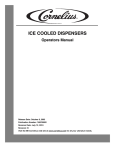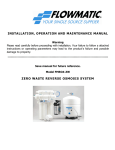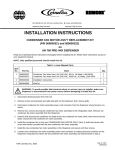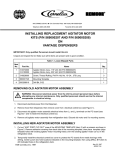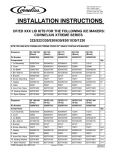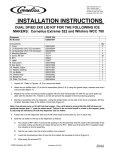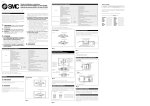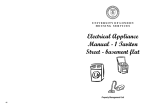Download Installation Manual 10/08/2003
Transcript
www.cornelius.com Telephone (800) 238-3600 INSTALLATION INSTRUCTION THIS INSTALLATION INSTRUCTION APPLIES TO ALL MODELS OF DROP-IN AND FREE-STANDING ICE COOLED DISPENSERS. UNPACKING AND INSPECTION The unit was thoroughly inspected before leaving the factory and the carrier has accepted and signed for it. Any damage or irregularities should be noted at the time of delivery and immediately reported to the delivery carrier. Request a written inspection report from Claims Inspector to substantiate any necessary claim. Claims must be filed with the delivery carrier. SELECTING A LOCATION CAUTION: Water pipe connections and fixtures directly connected to a potable water supply shall be sized, installed and maintained according to federal, state and local laws. The dispenser must be located near a permanent drain to route and connect unit ice bin and drip tray drain hoses. All drains and connections to such drains must meet local plumbing codes. Units with electrically operated valves must be located near a properly grounded electrical outlet. Circuit should be fused and no other electrical appliance should be connected to the circuit. ALL ELECTRICAL WIRING MUST CONFORM TO NATIONAL AND LOCAL ELECTRICAL CODES. INSTALLING THE DISPENSER Drop-In Dispenser 1. Use the Template supplied to mark the location of the hole to be cut into the counter top. Cut the hole as marked and remove the material. 2. Apply the double stick tape (if supplied with the loose shipped parts). Note: To comply with the National Sanitation Foundation (NSF) requirements, the unit must be sealed to the counter top. 3. Liberally apply a sealant, such as Dow Corning RTV 731 or equivalent, to the unit flange bottom surface. 4. Lower the unit into position to complete the seal of the rim to the counter top. Apply additional sealant around the rim to ensure a complete seal. Note: Do not move the unit after positioning or the seal will be broken. EIMI Cornelius Inc; 1994–2003 1 10/4/94 Revised 10/8/03 166239001 Rev. Level1 5. Remove any excess sealant. Note: For non-electrical valves, skip the next step. 6. Mount the Transformer power supply under the counter, in a position to allow access to the electrical outlet and to allow the 24V power cord to reach the dispenser. 7. Install the drain hose to the ice bin drain fitting and route the drain hose to a permanent drain. Free-Standing Dispenser 1. Install the 6“ legs to the dispenser cabinet if they are to be used. 2. Place the dispenser in the location selected. Be sure the dispenser is level. This is important to ensure that the bin drains properly. 3. Mount the Transformer power supply in a convenient location to allow access to the electrical outlet and to allow the 24V power cord to reach the dispenser. 4. Install the drain hose to the ice bin drain fitting and route the drain hose to a permanent drain. SANITIZING PRODUCT COLD PLATE TUBING Preparing the Cleaning Solution: Using a clean tank (tank system) or a five-gallon container (bag-in-box system), prepare a full tank or container of liquid dishwasher detergent by using 70° F (21° C) to 100° F (38° C) potable water and 0.5 oz. (15 ml) of liquid dishwasher detergent (such as Joy, Ivory, etc.) to one gallon of potable water. Shake detergent solution to thoroughly mix the solution. Preparing the Sanitizing Solution: Using a clean tank (tanks system) or a five-gallon container (bag-in-box system), prepare sanitizing solution using 70° F (21° C) to100° F (38° C) potable water and 0.5 oz. (15 ml) of household liquid bleach such as non-scented Hi-Lex or Chlorox that contains a 5.25 % sodium hypochlorite concentration to one gallon of potable water.This mixture must not exceed 200 PPM of chlorine. Shake sanitizing solution to thoroughly mix. STEP 1. WASH PRODUCT/SYRUP SYSTEMS 1. Using a clean tank (tank system) or a five-gallon container (bag-in-box system), prepare a full tank or container of liquid dishwasher detergent by using 70° F (21° C) to 100° F (38° C) potable water and 0.5 oz. (15 ml) of liquid dishwasher detergent (such as Joy, Ivory, etc.) to one gallon of potable water. Shake detergent solution to thoroughly mix the solution. Tank Systems. A. Observe and note CO2 pressure setting on the tanks CO2 regulator, then re-adjust CO2 regulator to 60 to 80-psi. Pressurize the tank containing detergent solution to 60 to 80-psi. B. Connect detergent solution tank, pressurized at 60 to 80-psi, into one of the tubing systems. Bag-in Box Systems. C. Install bag valves (cut from empty bag-in-box syrup containers) on ends of syrup containers syrup outlet tubes connectors. D. Place all syrup outlet tubes, with bag valves on their ends, in container containing detergent solution. 2. Flush the syrup system and dispensing valve as follows: A. Place waste container under applicable dispensing valve. B. Activate the dispensing valve for one minute to purge all syrup and flush out the syrup system. EIMI Cornelius Inc; 1994–2003 2 10/4/94 Revised 10/8/03 166239001 Rev. Level 1 C. Continue to activate the dispensing valve in cycles (“ON” for 15-seconds, “OFF”, then “ON” for 15-seconds). Repeat “ON” and “OFF” cycles for 15-cycles. 3. Connect detergent solution to remaining syrup systems and flush syrup out of syrup systems as instructed in step 2 preceding. 4. Remove detergent solution source from the syrup system. STEP 2. FLUSH COOLING SYSTEMS Tank Systems. 1. Connect tank containing potable water, pressurized at 60 to 80-psi, into one of the tubing systems. Bag-in-Box Syrup System. 2. Fill five-gallon container with potable water, then place all bag-in-box syrup containers syrup outlet tubes in container containing potable water. A. Flush detergent solution out of syrup system and dispensing valve as follows: B. Place waste container under applicable dispensing valve. C. Activate the dispensing valve for one minute to purge all detergent solution and flush out of the syrup system. D. Continue to activate the dispensing valve in cycles (“ON” for 15-seconds, “OFF”, then “ON” for 15-seconds). Repeat “ON” and “OFF” cycles for 15-cycles. 3. Connect potable water source to remaining syrup systems and flush detergent solution out of syrup systems as instructed in step A preceding. 4. Remove potable water source from the syrup system. STEP 3. SANITIZE COOLING SYSTEMS 1. Using a clean tank (tanks system) or a five-gallon container (bag-in-box system), prepare sanitizing solution using 70° F (21° C) to100° F (38° C) potable water and 0.5 oz. (15 ml) of household liquid bleach such as non-scented Hi-Lex or Chlorox that contains a 5.25 % sodium hypochlorite concentration to one gallon of potable water.This mixture must not exceed 200 PPM of chlorine. Shake sanitizing solution to thoroughly mix. Tank Systems. A. Connect sanitizing solution tank, pressurized at 60 to 80-psi, into one of the tubing systems. Bag-in-Box Syrup System. B. Place all bag-in-box syrup containers syrup outlet tubes in container containing sanitizing solution. 2. Sanitize the syrup system and dispensing valve as follows: A. Place waste container under applicable dispensing valve. B. Activate the dispensing valve for one minute to purge all water from and install sanitizing solution in the syrup system and dispensing valve. C. Continue to activate the dispensing valve in cycles (“ON” for 15-seconds, “OFF”, then “ON” for 15-seconds). Repeat “ON” and “OFF” cycles for 15-cycles. 3. Repeat steps to flush water out of and install sanitizing solution in the remaining syrup systems and dispensing valves. EIMI Cornelius Inc; 1994–2003 3 10/4/94 Revised 10/8/03 166239001 Rev. Level 1 4. Remove sanitizing solution source from the syrup system. 5. Allow sanitizing solution to remain in the syrup systems for not less than 10 or no more than 15-minutes (max.) contact time. STEP 4. WATER FLUSH SYSTEMS WARNING: Flush sanitizing solution from the systems as instructed. Residual sanitizing solution left in the systems could create a health hazard. 1. Fill tank (tank system) or a five-gallon container (bag-in-box system) with potable water. Tank Systems. A. Connect tank containing potable water, pressurized at 60 to 80-psi, into one of the systems. Bag-in-Box Syrup System. B. Place all bag-in-box syrup containers syrup outlet tubes in container containing potable water. 2. Flush sanitizing solution from the syrup system and the dispensing valve as follows: A. Place waste container under applicable dispensing valve. B. Activate the dispensing valve for one minute to purge all sanitizing solution out of the syrup system and the dispensing valve. C. Continue to activate the dispensing valve in cycles (“ON” for 15-seconds, “OFF”, then “ON” for 15-seconds). Repeat “ON” and “OFF” cycles for 15-cycles. 3. Repeat preceding steps to purge sanitizing solution out of the remaining syrup systems and dispensing valves. 4. Remove potable water source from the syrup system. STEP 5. PURGE WATER (RESTORE OPERATION) Tank Systems. 1. Noting tanks CO2 regulator pressure setting observed in step 4 preceding, readjust CO2 regulator to the observed pressure setting, A. Connect tanks containing the product onto the system. Bag-in-Box Syrup System. B. Remove all bag valves from bag-in-box syrup containers outlet tubes connectors. C. Connect bag-in-box syrup containers into the syrup systems. 2. Place waste container under dispensing valves. Dispense from all dispensing valves to permit syrup to purge all potable water from the syrup systems and the dispensing valves. Continue to dispense from the dispensing valves until only syrup is dispensed from the syrup systems and valves. WARNING: To avoid possible personal injury or property damage, do not attempt to remove the syrup tank cover until CO2 pressure has been released from the tank. 3. Dispose of waste sanitizing solution in sanitary sewer, not in storm drain, then thoroughly rinse inside and outside of the container that was used for sanitizing solution to remove all sanitizing solution residue. EIMI Cornelius Inc; 1994–2003 4 10/4/94 Revised 10/8/03 166239001 Rev. Level 1 CLEANING THE ICE BIN 1. Prepare a mild detergent soap solution in 100)F potable water. 2. Using a nylon (not wire) bristle brush, clean the cold plate and the interior of the ice bin with the soap solution. 3. Rinse the cold plate and interior bin surfaces with clean potable water. 4. Using a mechanical spray bottle, prepare a sanitizing solution according to the manufacturer’s directions and spray the entire interior bin surfaces. Allow to air dry. CONNECTING PRODUCT TO THE DISPENSER Note: All inlet connections are clearly marked with a label adjacent to the inlet connections. Note: Always leak check all connections. Post–Mix units must have syrup, carbonated water and plain water connected. The number of syrups will depend on the number of valves on the dispenser. Refer to the plumbing diagram for details of the hookup. Pre-Mix units must have a pre-mix supply connected to each inlet for each valve to be supplied. Refer to the plumbing diagram for details of the hook-up. Note: A plumbing diagram when supplied with the unit, can be found in the dispensing tower. PREPARING FOR OPERATION On Units Without Electrically Operated Valves, Skip Steps 1 & 2 Below 1. Plug transformer into electrical outlet. The 24V supply must be connected in the dispensing tower. 2. Turn the key-switch to the ON position. The ice-bin lid must be closed to allow the valves to operate. 3. Adjust the CO2 regulators as indicated in the following chart: Post-Mix Regulator Pressure Setting Primary (Carbonator) 90 – 120 PSI Secondary, Sugared Syrup Tank 55 PSI Secondary, Diet Syrup Tank 8 – 12 PSI Secondary, B–I–B 60 PSI Pre-Mix Basic pressure shown is based on ambient temperature of 72)F. Use a Cornelius Pre-Mix slide rule for exact calculations. Basic Pressure 47 PSI For each 10 ft. of horizontal tubing between tank and dispenser Add 1 PSI For each 2 ft. of elevation Add 1 PSI For each tank per flavor over 3 tanks Add 1 PSI 4. Operate each valve until product is flowing. EIMI Cornelius Inc; 1994–2003 5 10/4/94 Revised 10/8/03 166239001 Rev. Level 1 5. Fill the bin with 32)F ice. DO NOT use ice taken directly from a freezer. 6. Adjust the brix (water-to-syrup ratio) for post-mix valves. 7. Set the flow rate for pre-mix valves. DRINK DISPENSER VALVES IMI CORNELIUS INC. MASON CITY IA. DRINK DISPENSERS VALVE TYPE MANUFACTURER PORTION CONTROL MAXIMUM OPERATING PRESSURE CORNELIUS 130 psi LANCER 100psi FLOWMATIC 100psi McCANN 130psi PUSH BUTTON CORNELIUS 130psi LANCER 100psi FLOWMATIC 100psi McCANN 130psi LEVER TYPE CORNELIUS 130psi LANCER 100psi FLOWMATIC 100psi McCANN 130psi AUTOFILL LEVER CORNELIUS 130psi LANCER 100psi FLOWMATIC 100psi McCANN 130psi NON–ELECTRIC CORNELIUS 130psi LANCER 100psi PREMIX TYPE CORNELIUS EIMI Cornelius Inc; 1994–2003 130psi 6 10/4/94 Revised 10/8/03 166239001 Rev. Level 1 TROUBLESHOOTING TROUBLESHOOTING Trouble ADJUSTMENT OF DISPENSING VALVE SYRUP FLOW REGULATOR DOES NOT INCREASE TO DESIRED WATER-TO-SYRUP ‘‘RATIO’’ Probable Cause Remedy A. Dispensing valve syrup flow regulator, syrup tank quick disconnect, or syrup line restricted. A. Sanitize syrup system as instructed. B. Syrup tank quick disconnects not secure. B. Secure quick disconnects. C. Syrup tanks secondary CO2 regulator out of adjustment. C. Adjust syrup tanks secondary CO2 regulator as instructed. D. No syrup supply. D. Replenish syrup supply. E. Improper syrup Baume. E. Replace syrup supply. F. Dirty or inoperative piston or spring in dispensing valve syrup flow regulator. F. Disassemble and clean dispensing valve syrup flow regulator. G. Tapered nylon washer inside tube swivel nut connector distorted from being overtightened. G. Replace nylon washer and make sure it seats properly. ADJUSTMENT OF DISPENSING VALVE SYRUP FLOW REGULATOR DOES NOT DECREASE TO DESIRED WATER-TO-SYRUP ‘‘RATIO’’ A. Dirty or inoperative piston or spring in dispensing valve syrup flow regulator. A. Disassemble and clean dispensing valve syrup flow regulator. DISPENSED PRODUCT CARBONATION TOO LOW A. Carbonator primary CO2 regulator out of adjustment for existing water conditions or temperature. A. Adjust carbonator primary CO2 regulator (Reference manual provided with carbonator). B. Air in carbonator tank. B. Vent air out of carbonator tank through relief valve. Actuate dispensing valve carbonated water lever to make carbonator pump cycle on. C. Water, oil, or dirt, in CO2 supply. C. Remove contaminated CO2. Clean CO2 system (lines, regulators, etc.) using a mild detergent. Install a clean CO2 supply. EIMI Cornelius Inc; 1994–2003 7 10/4/94 Revised 10/8/03 166239001 Rev. Level 1 Trouble DISPENSED PRODUCT COMES OUT OF DISPENSING VALVE CLEAR BUT FOAMS IN CUP OR GLASS Probable Cause Remedy A. Oil film or soap scum in cup or glass. A. Use clean cup or glass. B. Ice used for finished drink is sub-cooled. B. Do not use ice directly from freezer. Allow ice to become ‘‘wet’’ before using. (Refer to following NOTE). NOTE: Crushed ice in the glass also causes dispensing problems. When finished drink hits sharp edges of ice, carbonation is released from dispensed drink. C. Carbonator CO2 regulator pressure too high for existing water conditions or temperature. C. Reduce carbonator CO2 regulator pressure setting. Reference manual provided with carbonator. D. Syrup over-carbonated with CO2 as indicated by bubbles in inlet syrup lines leading to unit. D. Remove syrup tanks quick disconnects. Relieve tank CO2 pressure, shake tank vigorously, then relieve tank CO2 pressure as many times as necessary to remove over-carbonation. E. Warm Product - No ice in bin, bridged ice on cold plate or plugged drain. E. Replenish ice, break ice up to eliminate bridging, unplug the drain. NOTE: If water supply is dirty, be sure to flush lines and carbonator completely. It may be necessary to remove lines to carbonator tank. Invert and flush tank and all inlet lines to remove any foreign particles or dirt. NO PRODUCT DISPENSED FROM ONE DISPENSING VALVE ONLY CARBONATED WATER DISPENSED EIMI Cornelius Inc; 1994–2003 A. Broken or disconnected wiring. A. Repair or connect wiring. B. Inoperative dispensing valve solenoid coil. B. Replace solenoid coil as instructed. C. Inoperative dispensing valve micro switch. C. Replace micro switch as instructed. A. Quick disconnects not secure on syrup tanks. A. Secure quick disconnects on syrup tanks. B. Out of syrup. B. Replenish syrup supply as instructed. C. B-I-B connectors not properly connected. C. Properly attach the connectors. D. Syrup secondary CO2 regulator not properly adjusted. D. Adjust syrup tanks secondary CO2 regulator as instructed. E. Inoperable dispensing valve. E. Repair dispensing valve. F. Dispensing valve syrup flow regulator not properly adjusted. F. Adjust dispensing valve syrup flow regulator (Water-to-Syrup ‘‘Ratio’’) as instructed. 8 10/4/94 Revised 10/8/03 166239001 Rev. Level 1 Trouble Probable Cause Remedy ONLY CARBONATED WATER DISPENSED, Continued G. Dispensing valve syrup flow regulator, syrup tank quick disconnect, or syrup lines restricted. G. Sanitize syrup system as instructed. ONLY SYRUP DISPENSED A. Plain water inlet supply line shutoff valve closed. A. Open plain water inlet supply line shutoff valve. B. Carbonator power cord unplugged from electrical outlet. B. Plug carbonator power cord into electrical outlet. C. Carbonator primary CO2 regulator not properly adjusted. C. Adjust carbonator primary CO2 regulator (Reference manual provided with carbonator). EIMI Cornelius Inc; 1994–2003 9 10/4/94 Revised 10/8/03 166239001 Rev. Level 1









